I’ve done a lot of crunchy things in my life…but my husband can attest to the fact that making almond milk from scratch has taken green living to a whole new level. Last month, I had an opportunity to meet with Veronica Bosgraaf, founder of Pure Bar (Organic, Gluten-Free Vegan Snack Bars). Her story is quite interesting…at the age of six, her daughter made the decision to become a vegetarian after visiting a petting zoo and making the connection between the animals she interacted with and the food on her plate. As she explored new ways to eat with her daughter, she saw a need for healthy vegetarian snacks. Together they worked to create snack bars using organic fruits and nuts free from pesticides.
During breakfast, we had an engaging conversation about the foods we eat. The topic of alternatives to cow’s milk came up, and I shared how both of my children drink Almond Milk due to food allergies. In fact, the amount of dairy consumed in our household is very minimal these days, since foods like ice cream, cheese, and even yogurt can be made with cow’s milk alternatives. But what exactly is in those foods? Is it really possible to take something like rice and make it into a cheese with the resulting food still being something “natural?”
We typically purchase Silk Almond Milk, and for the most part, the ingredients are recognizable: Filtered Water, Almonds, Cane Sugar, Sea Salt. But then we get to Locus Bean Gum, Sunflower Lecithin, and Gellan Gum. I had to do a bit of “Googling” to find out that these 3 ingredients are used to thicken, emulsify, and stabilize food products. While they seem to be pretty benign, I’m not entirely sure whether those ingredients are ok to consume on a daily basis.
Interestingly enough, many brands that sell almond milk actually include a thickening agent called Carrageenan. Since the safety of this ingredient has been questioned, I avoid it when possible. But a quick glance at my local store’s options for Almond Milk only resulted in one (Silk) that did not contain this ingredient. As we were discussing this very topic, Veronica explained to us how she makes her own almond milk. I was intrigued. Her recipe simply contains Coconut Water and Almonds blended and strained at a ratio of 2:1. It sounded so easy! But could I do it?
Since my son has had a sensitivity to coconut, I did some more research, and spoke to my friend Angela from Nine More Months. Her “recipe” simply includes filtered water and almonds, so I decided to make my own almond milk with a few “additions.”
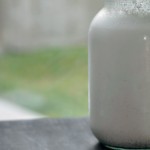
- 1 Cup Raw Almonds
- 3 Cups Filtered Water
- 1/2 Tablespoon Agave Nectar
- 1 Vanilla Bean
-
Soak the almonds in water overnight (approximately 8-12 hours)
-
Drain the almonds
-
Place them in a blender with 3 cups of filtered water and blend
-
Strain
-
Add vanilla bean (sliced lengthwise to remove the seeds) and agave tot he almond milk and blend lightly until combined
-
Refrigerate and serve
At some point, when my husband walked in and found me straining the milk through cheesecloth, he just shook his head. I think he felt like my crunchiness had gotten a bit out of control. But I felt so accomplished after doing this and the milk seriously tasted good. Even my husband enjoyed it!
Here is my visual, step-by-step process detailing how to make Homemade Almond Milk:
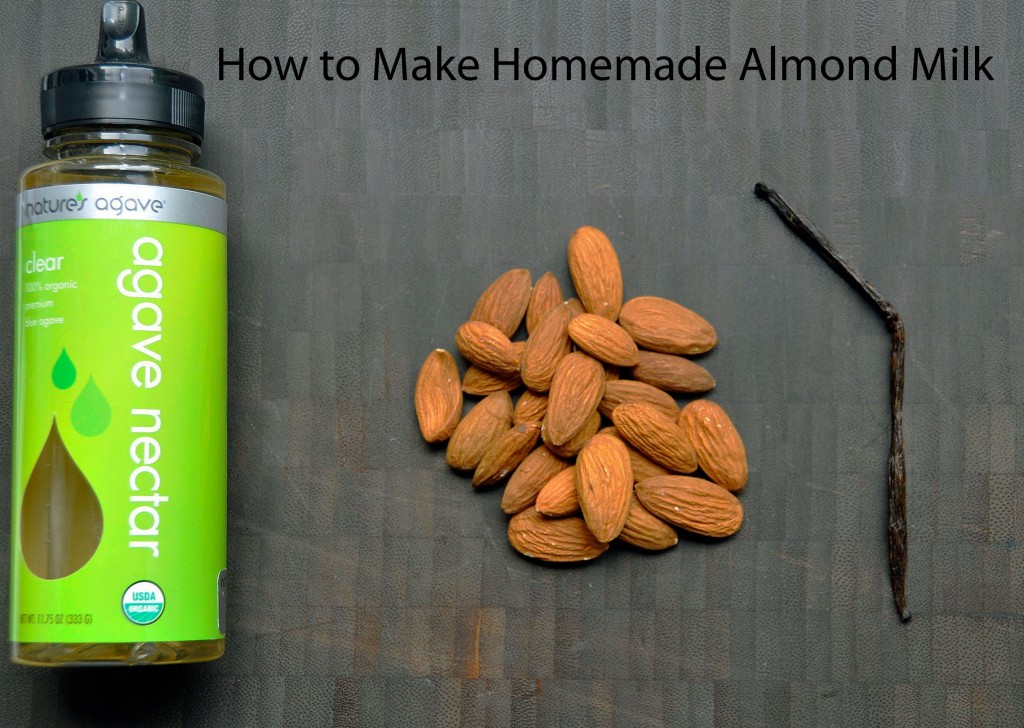
Here is all you need to make fresh, homemade almond milk
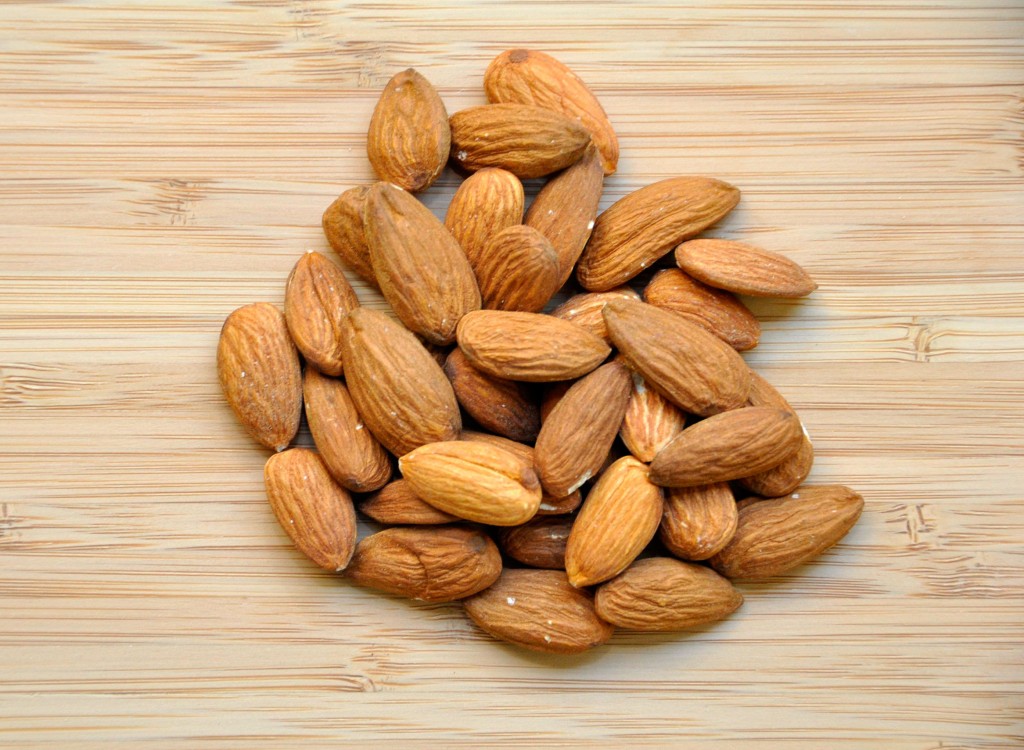
Soak raw almonds in filtered water for 8-12 hours
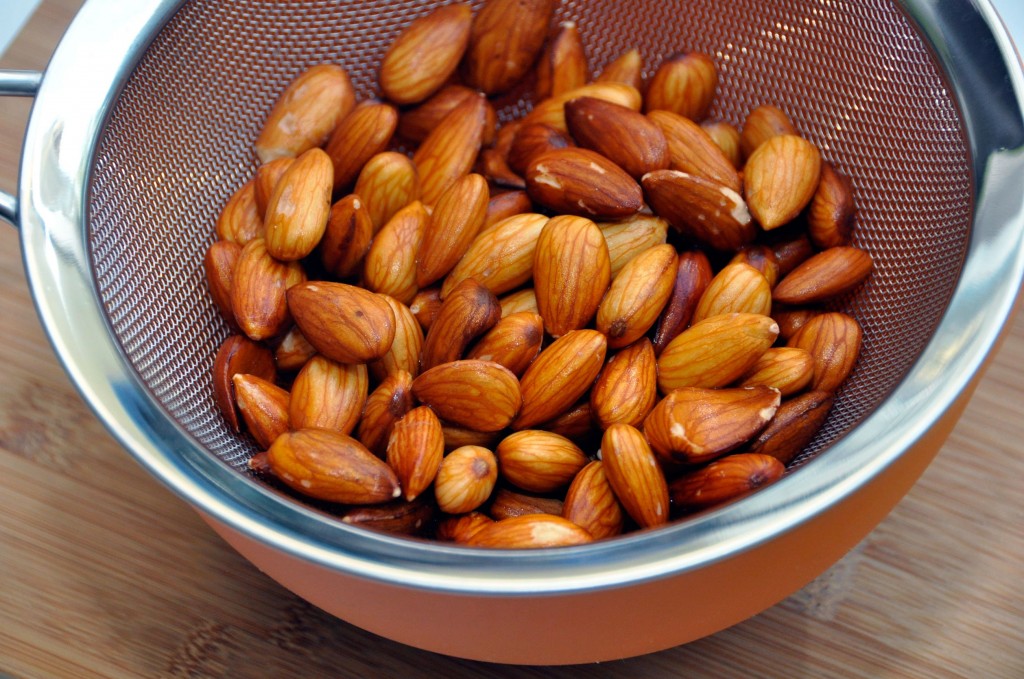
Drain and rinse sprouted almonds
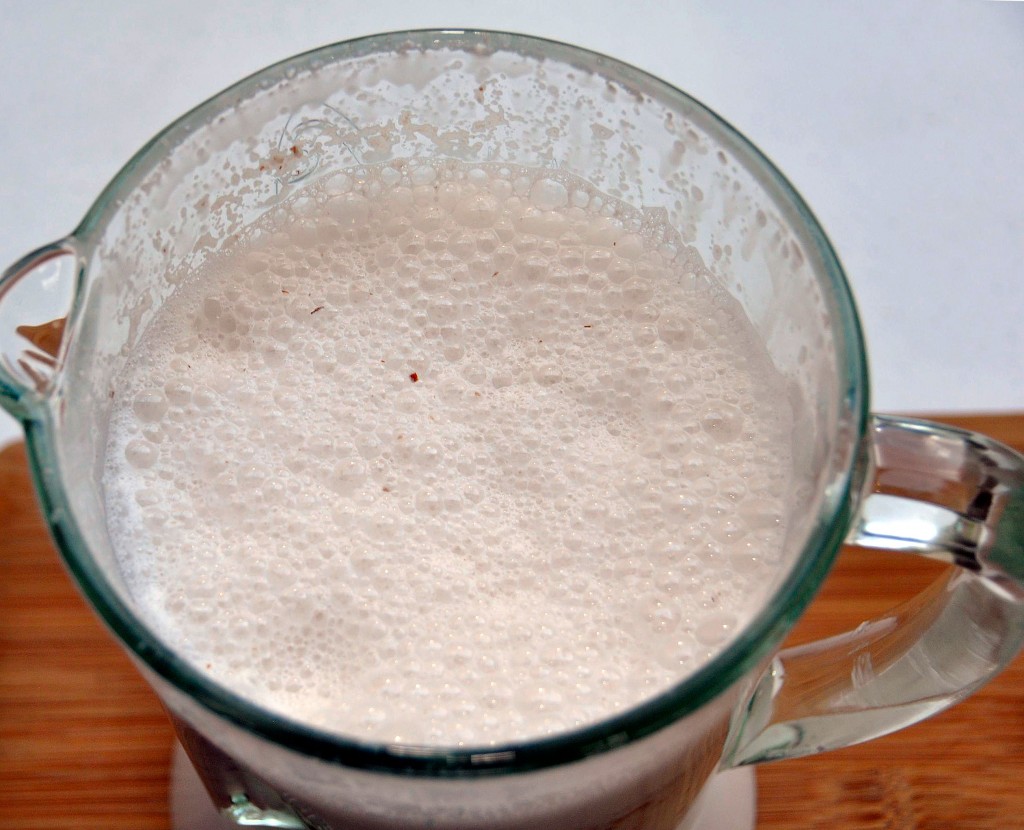
Blend sprouted almonds and filtered water until smooth
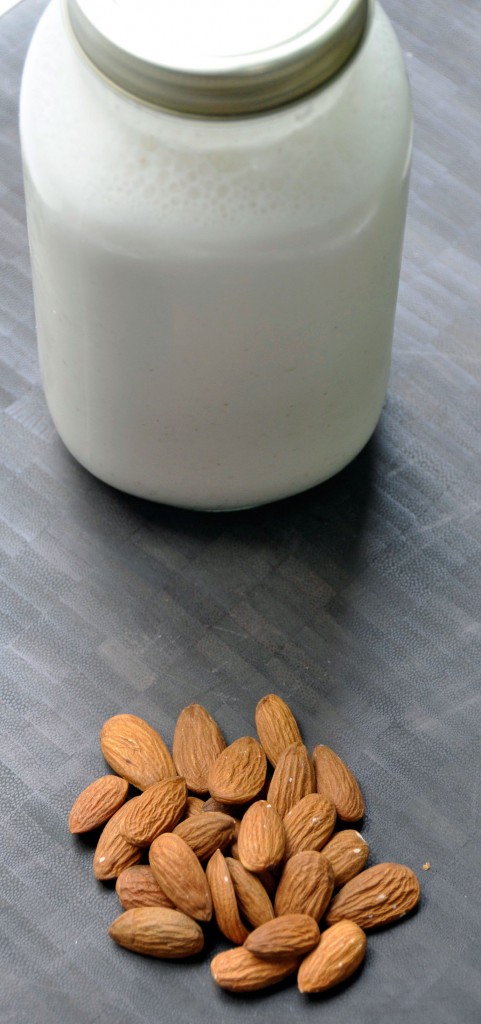
Strain, then lightly blend in seeds from the vanilla bean and agave nectar
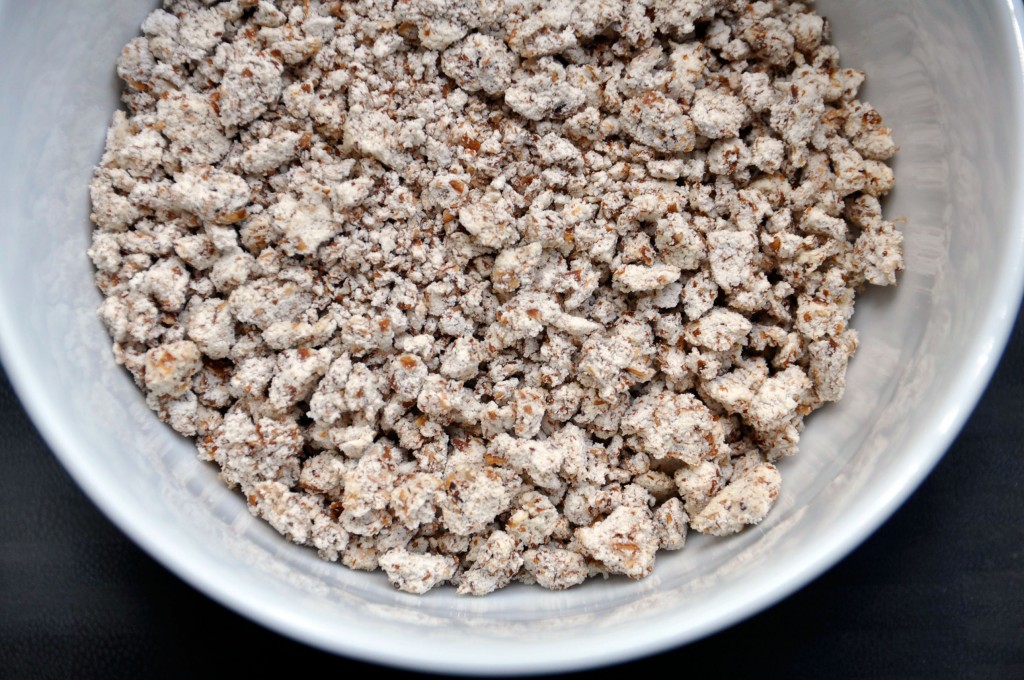
Dry out almond pulp and process to make almond meal
After going through the process of making almond milk from scratch, I have a few tips and pointers that I think will help streamline the process.
1. Be sure to use raw almonds (sprouted almonds do not need to be soaked)
2. Try to use a quality blender, such as a Vitamix
3. Consider investing in a nut milk bag if you plan to make almond milk at home regularly
4. Save the almond pulp and dry it out in the oven (lowest setting for 2-4 hours). Use the food processor to grind it up into almond meal and use it in breads or to coat fish.
5. Try adding cinnamon, maple syrup, chocolate or anything else you desire to give your almond milk a bit of flavor
6. Adjust the ratio of almonds and filtered water for a thicker or thinner milk
7. Remember that since there are no preservatives, the milk will only last 4 or 5 days. Consider doubling this recipe if you consume a lot of almond milk in one week.
8. Since there are no added vitamins or minerals, be sure that you (and your children) are getting essentials like Calcium and Vitamin D from other sources.
9. Be sure to shake the milk before using because it will separate.
Have you ever made homemade almond milk? I’d love to hear your stories and techniques!
Images: Rockin’ Mama.
- Discover Luxury at Sonesta Irvine: Your Ideal Staycation - August 8, 2024
- CHOC Walk Returns to the Disneyland Resort – Special Events and Ways to Support - June 28, 2023
- Beastly Ball Returns to the Los Angeles Zoo - May 8, 2023

SO MUCH FOR THE MYTHS
CONSIDER THE FACTS ON CARRAGEENAN FOR A CHANGE
Q. What is Carrageenan??
A. Carrageenan is a naturally-occurring seaweed extract. It is widely used in foods and non-foods to improve texture and stability. Common uses include meat and poultry, dairy products, canned pet food, cosmetics and toothpaste.
Q. Why the controversy?
A. Self-appointed consumer watchdogs have produced numerous web pages filled with words condemning carrageenan as an unsafe food additive for human consumption. However, in 70+ years of carrageenan being used in processed foods, not a single substantiated claim of an acute or chronic disease has been reported as arising from carrageenan consumption. On a more science-based footing, food regulatory agencies in the US, the EU, and in the UN’s Food and Agriculture Organization/World Health Organization (FAO/WHO) repeatedly review and continue to approve carrageenan as a safe food additive.
Q. What has led up to this misrepresentation of the safety of an important food stabilizer, gelling agent and thickener?
A. It clearly has to be attributed to the research of Dr. Joanne Tobacman, an Associate Prof at the University of Illinois in Chicago. She and a group of molecular biologists have accused carrageenan of being a potential inflammatory agent as a conclusion from laboratory experiments with cells of the digestive tract. It requires a lot of unproven assumptions to even suggest that consumption of carrageenan in the human diet causes inflammatory diseases of the digestive tract. The objectivity of the Chicago research is also flawed by the fact that Dr Tobacman has tried to have carrageenan declared an unsafe food additive on weak technical arguments that she broadcast widely a decade before the University of Chicago research began.
Q. What brings poligeenan into a discussion of carrageenan?
A. Poligeenan (“degraded carrageenan” in pre-1988 scientific and regulatory publications) is a possible carcinogen to humans; carrageenan is not. The only relationship between carrageenan and poligeenan is that the former is the starting material to make the latter. Poligeenan is not a component of carrageenan and cannot be produced in the digestive tract from carrageenan-containing foods.
Q. What are the differences between poligeenan and carrageenan?
A. The production process for poligeenan requires treating carrageenan with strong acid at high temp (about that of boiling water) for 6 hours or more. These severe processing conditions convert the long chains of carrageenan to much shorter ones: ten to one hundred times shorter. In scientific terms the molecular weight of poligeenan is 10,000 to 20,000; whereas that of carrageenan is 200,000 to 800,000. Concern has been raised about the amount of material in carrageenan with molecular weight less than 50,000. The actual amount (well under 1%) cannot even be detected accurately with current technology. Certainly it presents no threat to human health.
Q. What is the importance of these molecular weight differences?
A. Poligeenan contains a fraction of material low enough in molecular weight that it can penetrate the walls of the digestive tract and enter the blood stream. The molecular weight of carrageenan is high enough that this penetration is impossible. Animal feeding studies starting in the 1960s have demonstrated that once the low molecular weight fraction of poligeenan enters the blood stream in large enough amounts, pre-cancerous lesions begin to form. These lesions are not observed in animals fed with a food containing carrageenan.
Q. Does carrageenan get absorbed in the digestive track?
A. Carrageenan passes through the digestive system intact, much like food fiber. In fact, carrageenan is a combination of soluble and insoluble nutritional fiber, though its use level in foods is so low as not to be a significant source of fiber in the diet.
Summary
Carrageenan has been proven completely safe for consumption. Poligeenan is not a component of carrageenan.
Closing Remarks
The consumer watchdogs with their blogs and websites would do far more service to consumers by researching their sources and present only what can be substantiated by good science. Unfortunately we are in an era of media frenzy that rewards controversy.
Additional information available:
On June 11th, 2008, Dr. Joanne Tobacman petitioned the FDA to revoke the current regulations permitting use of carrageenan as a food additive.
On June 11th, 2012 the FDA denied her petition, categorically addressing and ultimately dismissing all of her claims; their rebuttal supported by the results of several in-depth, scientific studies.
If you would like to read the full petition and FDA response, they can be accessed at http://www.regulations.gov/#!searchResults;rpp=25;po=0;s=FDA-2008-P-0347